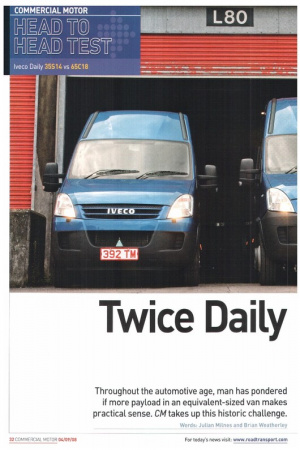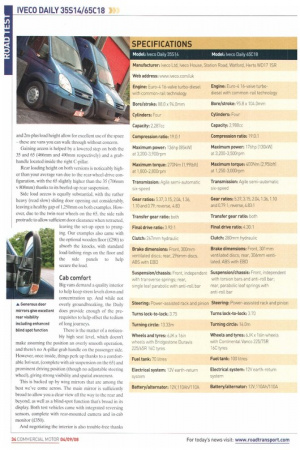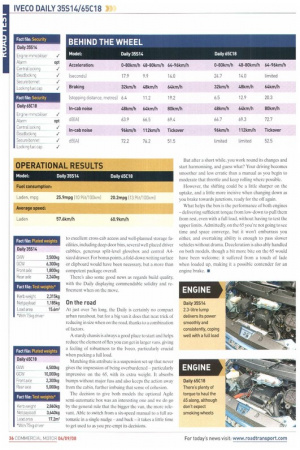Twice Daily
Page 32

Page 33

Page 34

Page 36

If you've noticed an error in this article please click here to report it so we can fix it.
Throughout the automotive age, man has pondered if more payload in an equivalent-sized van makes practical sense. CM takes up this historic challenge.
Words: Julian Miles and Brian 1,^4eatherley Vans over 3 500kg gross vehicle weight (GVW) are few and far between on UK roads, with most buyers opting for either a big rear-wheel drive 3,500kg example, or a full-blown small truck at 7,500kg.
However, considering load volume can reach a prodigious 17m3, with payload a rather hefty 3,500kg-plus, heavy panel vans can make a practical alternative to a 7.5-tonne truck, and come with all the benefits of such vehicles.
They're easy to drive, come with spacious cabins, and the load area is generally more secure. In fact, those considering a 7.5-tonner can expect only an average 3,000kg payload once you factor in the box-body on top of the chassis-cab.
However, there is a flipside to the heavy panel-van argument.
Those looking to venture above 3,500kg GVW in the panel also incur the wrath of the tachograph, as well as a speed limiter (57mph), and, therefore, a decrease in productivity thanks to increased driving time.
Furthermore, if the designated driver passed their test after 1997, a Category Cl licence is required.
So, with this in mind, CM decided to weigh up the two options...
To make it fair and square, we decided to stick with one manufacturer in order to allow us to assess like for like.
Iveco's Daily has certainly proved itself at the heavier end of the van market, and its latest version has previously been given the CM thumbs-up.
In this instance, we recruited a 35S14 or to put it another way, a 3,500kg, 2.3-litre, 13611p version with longwheelbase and high roof. Yours for £24,300. it comes with a payload of 1,220kg and a load volume of 15.6in.
Just shading it for overall size is a 65C18. Coming in at 6,500kg GVW and powered by a 3.0-litre, 176hp engine, it packs a maximum payload of 3,640kg, with load volume of L7.2m3. Priced at £31,700, it is pretty much the daddy of panel vans, offering cavernous load potential in what is a surprisingly well-proportioned package both examples sport Iveco's agile semi-automatic gearboxes (£700).
As far as competition is concerned, Renault's Mascott (with which the Daily shares its underpinnings) is available up to 6,500kg, and both MercedesBenz and Volkswagen offer a 5,000kg Sprinter and Crafter respectively, while Ford has just rolled out a 4,600kg, 198hp Transit (which CM is soon to test).
Productivity
As fuel consumption figures go, our two contenders certainly make for an interesting comparison.
On the one hand, you have a 2.3-litre, 136hp engine and a payload of 1,220kg, wrapped inside a 3,500kg van, while in the other there's an uprated 3.0-litre unit with 176hp, a 3,640kg payload and a 6.500kg GVW. The 65 is limited to 57mph and, therefore, has an advantage in terms of driving economy... but will suffer in terms of journey time.
To keep things fair, we ran both gearboxes in automatic, below 3,000rprn where possible. We achieved 25.9mpg for the 35, although unfortunately, our journey time was hindered by one of those M25 mystery queues, and averaged a slow 57.6km/h on a normal day this tends to be around 65krin/h. For the 65, we managed 20.2mpg and an average journey speed of 6(19km/h theoretically a 5mpg and 5km/ h gain for the lighter van.
As for both load areas, you could probably get an echo out of them once you open the rear double doors both versions having standard 270" hinges that stayed fixed via protruding magnets on the exterior. The near flat side walls and 2m-plus load height allow for excellent use of the space — these are vans you can walk through without concern.
Gaining access is helped by a lowered step on both the 35 and 65 (466mm and 490mm respectively) and a grabhandle located inside the right C-pillar.
Rear loading height on both versions is noticeably higher than your average van due to the rear-wheel-drive configuration, with the 65 slightly higher than the 35 (706mm v 808mm) thanks to its beefed-up rear suspension.
Side load access is equally substantial, with the rather heavy (read slow) sliding door opening out considerably, leaving a healthy gap of 1,250mm on both examples. However, due to the twin-rear wheels on the 65, the side rails protrude to allow sufficient door clearance when retracted, leaving the set-up open to pranging. Our examples also came with the optional wooden floor (£290) to absorb the knocks, with standard load-lashing rings on the floor and the side panels to help secure the load.
Cab comfort Big vans demand a quality interior to help keep stress levels down and concentration up. And while not A Generous door overly groundbreaking, the Daily mirrors give excellent does provide enough of the pre rear visibility requisites to help offset the tedium including enhanced of long journeys.
blind spot function There is the matter of a noticea bly high seat level, which doesn't make assuming the position an overly smooth operation, and there's no A-pillar grab handle on the passenger side. However, once inside, things perk up thanks to a comfortable Isri seat, (complete with air suspension on the 65) and prominent driving position (though no adjustable steering wheel), giving strong visibility and spatial awareness.
This is backed up by wing mirrors that are among the best we've come across. The main mirror is sufficiently broad to allow you a clear view all the way to the rear and beyond, as well as a blind-spot function that broad in its display. Both test vehicles came with integrated reversing sensors, complete with rear-mounted camera and in-cab monitor (£350).
And negotiating the interior is also trouble-free thanks to excellent cross-cab access and well-planned storage facilities, including deep door bins, several well placed driver cubbies, generous split-level glovebox and central A4sized drawer. For bonus points, a fold-down writing surface or clipboard would have been necessary, but a more than competent package overall.
There's also some good news as regards build quality, with the Daily displaying commendable solidity and refinement when on the move.
On the road
At just over 7m long, the Daily is certainly no compact urban runabout, but for a big van it does that neat trick of reducing in size when on the road, thanks to a combination of factors.
A sturdy chassis is always a good place to start and helps reduce the element of flex you can get in larger vans, giving a feeling of robustness to the Iveco, particularly crucial when packing a full load.
Matching this attribute is a suspension set-up that never gives the impression of being overburdened particularly impressive on the 65, with its extra weight. It absorbs bumps without major fuss and also keeps the action away from the cabin, further imbuing that sense of cohesion.
The decision to give both models the optional Agile semi-automatic box was an interesting one and we do go by the general rule that the bigger the van, the more relevant. Able to switch from a six-speed manual to a full automatic in a single nudge and back it takes a little time to get used to as you pre-empt its decisions.
But after a short while, you work round its changes and start harmonising, and guess what? Your driving becomes smoother and less erratic than a manual as you begin to moderate that throttle and keep rolling where possible.
However, the shifting could be a little sharper on the uptake, and a little more incisive when changing down as you brake towards junctions, ready for the off again.
What helps the box is the performance of both engines delivering sufficient torque from low-down to pull them from rest, even with a full load, without having to test the upper limits. Admittedly, on the 65 you're not going to see time and space converge, but it won't embarrass you either, and overtaking ability is enough to pass slower vehicles without drama, Deceleration is also ably handled on both models, though a bit more bite on the 65 would have been welcome; it suffered from a touch of fade when loaded up, making it a possible contender for an engine brake. •




































































































































































